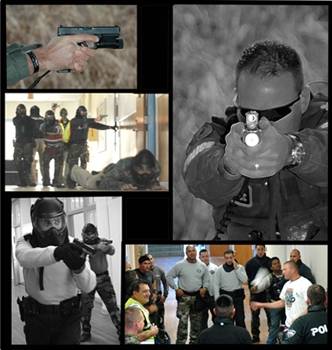ALERRT: New records in active shooter training

SAN MARCOS – A law enforcement training center headquartered at Texas State University-San Marcos is teaching active shooter response situations to police officers nationwide in record numbers, and that trend is expected to continue into the next fiscal year.
Texas State’s Advanced Law Enforcement Rapid Response Training program received more than $4.2 million in state and federal funding during the 2007 fiscal year. That funding was used to conduct 200 ALERRT classes, training more than 4,800 officers in active shooter response and teaching another 200 to be ALERRT trainers in FY07.
Those are record numbers for ALERRT, and Don Montague, director of the program, said the demand for training is increasing.
“As we reach the end of fiscal year 2007, we have more than 200 agencies across the nation on a waiting list for the ALERRT active shooter course, with more requests arriving daily,” said Montague.
Montague said he expects ALERRT to conduct nearly 300 classes in 2007-08. Most of those classes will instruct first responding officers in active shooting response techniques. More than 20 classes, though, are so-called “Train-the-Trainer” classes that teach officers to become ALERRT trainers themselves and then carry the training back to their home police agency.
ALERRT received its first grants in 2002, and funding has increased every year. The center received $1.5 million in government grants in 2006, $4.2 million in 2007, and is expecting more than $5.5 million in FY 2008. Funding has come from a variety of sources, including the Texas Governor’s Office Criminal Justice Division, the U.S. Department of Justice Bureau of Justice Assistance and the U.S. Department of Defense.
The goal is to teach police officers, specifically the true first responders, to safely and effectively respond to, address and stop an active shooter.
“We teach first responder tactics and active shooter tactics that are based upon lessons learned from historical homicidal/suicidal acts of violence such as occurred at Columbine High School and Virginia Tech,” said Montague.
Incidents such as the massacre last spring at Virginia Tech increase the demand for ALERRT classes. In fact, in the aftermath of the Virginia Tech shooting spree, the Virginia Governor’s Office has requested a “Train-the-Trainer” ALERRT program that will teach 25 officers from several Virginia police agencies to be certified ALERRT instructors. That training will take place in late August in Richmond, Va., through Bureau of Justice Assistance funding.
ALERRT instructors will also conduct 41 classes for the Texas National Guard beginning in September. Another major project on the calendar for FY08, through the Mississippi Governor’s Office, will train 75 certified instructors who will then incorporate the ALERRT program into their statewide law enforcement academy program for the entire state of Mississippi.
The ALERRT basic active shooter training course is a dynamic two-day, 16-hour program that includes tactical team movements and building approaches, active shooter vs. barricade/hostage negotiation, survival stress reaction, low-light techniques, rescue team tactics, improvised explosive device training, safety briefing, and force-on-force practical exercises.
The training is delivered by veteran field officers who have had personal “boots on the ground” life experience in dealing with the new kind of terrorism that threatens communities. Since 2002, more than 14,000 law enforcement officers across the nation have received ALERRT active shooter training.
“The feedback we have received from participants overwhelmingly indicates that officers feel safer and better trained to handle violent crimes in progress because of this training. We believe it empowers first responding patrol officer to more effectively deal with acts of violence before they evolve into full-blown national tragedies,” said Montague.
ALERRT is a program of the Department of Criminal Justice in the College of Applied Arts at Texas State University. ALERRT partners with the Texas Engineering Extension Service at Texas A&M University.
-30-
Texas State University-San Marcos is a member of the Texas State University System